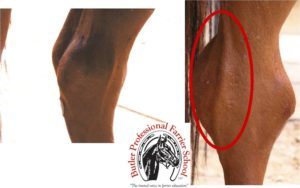Spavin

Bone spavin is an arthritis that usually involves deposits of bone growth on the inside of the hock (tarsus) joint. Also note the abnormally swollen saphenous vein (circled). This condition is referred to as blood spavin and comparable to varicose veins in people.
Hock spavin can be a real disappointment in many breeds and types of horses. We have received many donations at our school of horses with careers cut short by this disease.
Bone spavin or jack spavin is an arthritis that usually involves deposits of bone growth or an exostosis in the medial bones of the middle and/or lower hock joint. It may first appear as a soft swelling or bog spavin or begin as an arthritis.
Signs of spavin pain are evident when the affected hind leg is picked up or when the affected leg is made to support all the horse’s weight as the other is picked up. The horse will seem stiff and painful when it is being trimmed or shod. The shoe toe will be characteristically worn square due to the horse dragging its toe. There will be intermittent lameness, worse when first asked to move. There will be a lump on the inside of the hock, seen best when at a 45 degree angle to the leg. Many horses will warm out of the stiffness, but remain stiff and sore.
Horses that work off their hind quarters such as cutting horses, calf roping horses and jumping horses are most susceptible. Highly trained horses that are collected into a tight frame or that stop or turn fast are most likely to get it.
Genetics plays a big part since conformation is so highly heritable. A straight hock or an over bent hock can increase its incidence. Trimming the heel low and creating a broken back axis is especially stressful to the hock.
A sometimes effective treatment is the use of wedge heeled aluminum bar shoes and/or wedge pads to raise the hoof angle has helped many horses stay in the game a little longer. In the UK a calk and wedge shoe is used on the hind feet of aged jumpers and eventers. The classic spavin shoe is graduated in thickness and has a turned up toe to act as a wear plate.
Those with severe pain that inhibits their ability to function in top form are candidates for Adequan hock injections by the veterinarian. Diet supplements such as chondroitin sulfate and glucosamine have little effect in most cases. However, individual horses may be miraculously affected. The harder a horse is pushed to perform, the more likely he will respond to supplements. In my experience, routine mechanical balancing of the feet has a bigger effect than anything else in keeping a top performer sound.
Related Posts
-
-
Some horses have crooked legs. Some of these horses become l...Feb 07, 2020 / 0 comments
-
With the holidays approaching, we are offering a discount on...Nov 30, 2017 / 0 comments
Blog Categories
- Anatomy
- Best Business Practices
- Conformation
- Current Events
- Customer Service
- Draft Horse Shoeing
- Equine Soundness
- Essential Anatomy Kit
- Farrier Careers
- Farrier training
- Foal soundness
- Horse Care
- Horse Foot Care
- Horse Owner Tips
- Horsemanship
- Horseshoeing
- Horseshoeing History
- Iron and Forge Work
- Student Spotlight
- Uncategorized
- Veterinary Care
Blog Archives
Contact Us
Butler Professional Horseshoeing School
495 Table Road
Crawford, NE 69339
(800) 728-3826
jacob@dougbutler.com
Subscribe to Our Blog
Get Our Free e-Book!
If you think you want to become a farrier (or know someone who does), this book can help you make that decision. Horse owners will learn the importance of choosing a qualified farrier and how to select the “right” one.
[ Get the e-Book Now! ]
- Follow:
